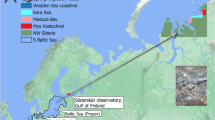Abstract.
The bird–lemming hypothesis postulates that breeding success of tundra-nesting geese and waders in Siberia follows the cyclic pattern of lemming populations, as a result of predators switching from lemmings to birds when the lemming population crashes. We present 50 years of data on constant-effort catches of red knot Calidris canutus and curlew sandpiper C. ferruginea at an autumn migratory stopover site (Ottenby) at the Baltic Sea, supplemented with literature data on winter censuses of dark-bellied brent goose Branta b. bernicla and white-fronted goose Anser albifrons in northwestern Europe, and waders in Germany and Southern Africa. Number and proportion of juveniles in these bird populations (both our own and literature data) were compared with an index of predation pressure (calculated from the abundance of lemmings on the Taimyr peninsula), and climate indices for the North Eurasia and the North Atlantic regions. The index of predation pressure correlated significantly with the number of juveniles of red knot and curlew sandpiper, but not with number of adults. Also, this index correlated with the reproductive performance of geese and waders reported in the literature. Fourier analysis revealed a significant deviation from random noise with the maximum spectral density at the period length of 3 years for number of juvenile red knots and curlew sandpipers captured at Ottenby, abundance of lemmings, reproduction in arctic fox Alopex lagopus, and reproductive performance in geese on the Siberian tundra. Also, the date of passage at Ottenby for adult red knot and curlew sandpiper showed a spectral density peak at a period length of 3 years, the latter species also showing a peak at a period length of 5–6 years. Passage dates for adult red knot and curlew sandpiper were earlier in years of high predation pressure compared with years of low predation pressure. The fluctuations in reproductive success of the studied Siberian goose and wader species appear to be primarily influenced by biotic factors in the breeding area, rather than by abiotic factors, such as climate oscillations. Annual variations in migratory arctic bird populations may have far reaching effects in habitats along their migration routes and in their wintering areas. We suggest a link between lemming cyclicity in the Northern Hemisphere and predation pressure on Southern Hemisphere benthos, in which the signal is carried between continents by long distance migrating waders.
Similar content being viewed by others
Author information
Authors and Affiliations
Corresponding author
Additional information
Electronic Publication
Rights and permissions
About this article
Cite this article
Blomqvist, S., Holmgren, N., Åkesson, S. et al. Indirect effects of lemming cycles on sandpiper dynamics: 50 years of counts from southern Sweden. Oecologia 133, 146–158 (2002). https://doi.org/10.1007/s00442-002-1017-2
Received:
Accepted:
Published:
Issue Date:
DOI: https://doi.org/10.1007/s00442-002-1017-2




